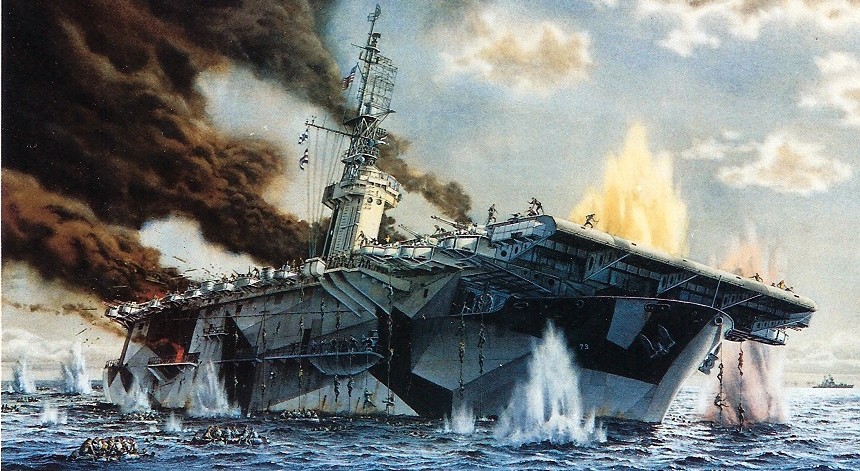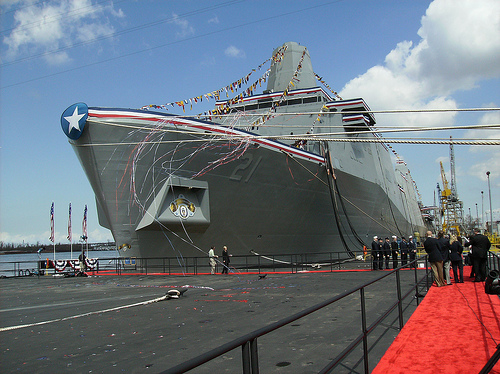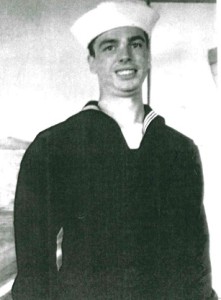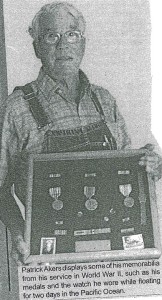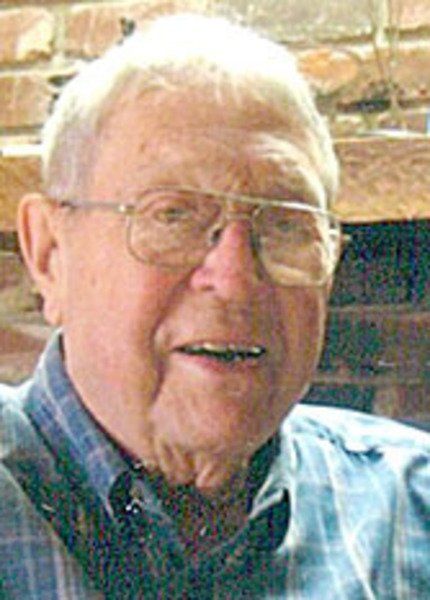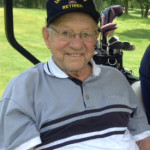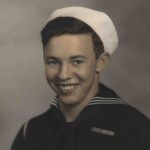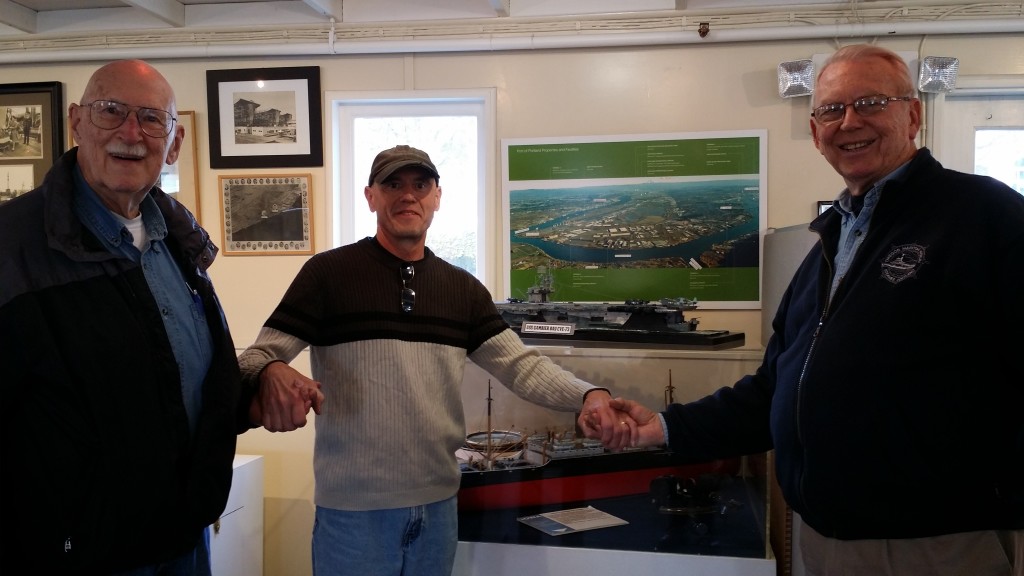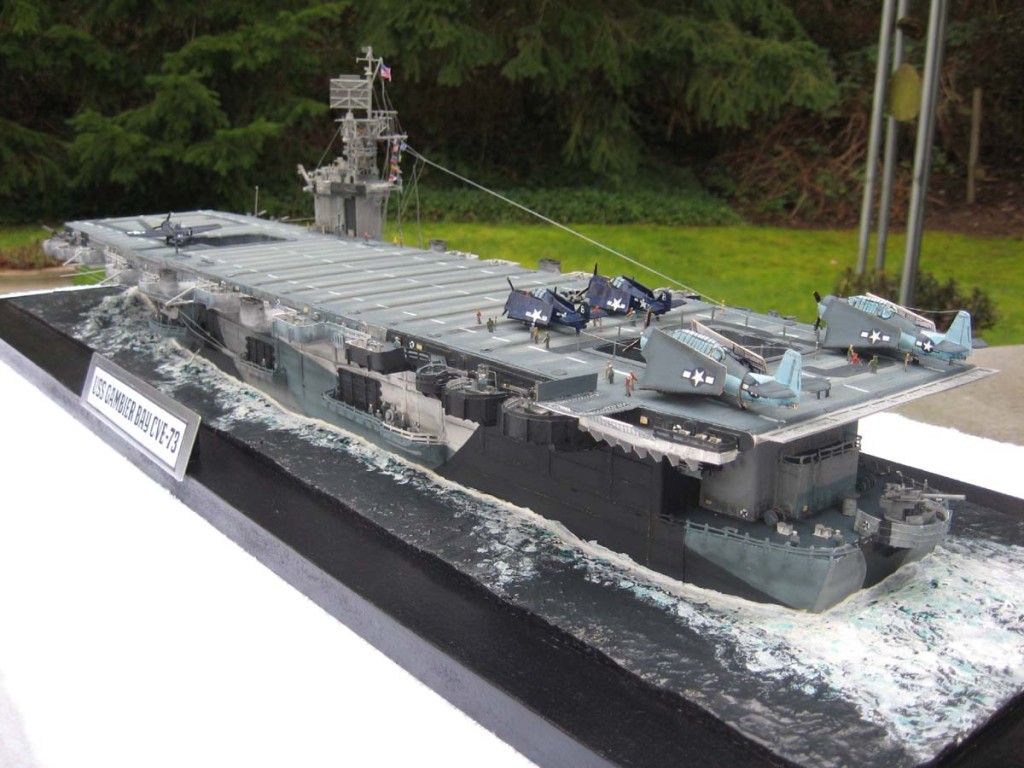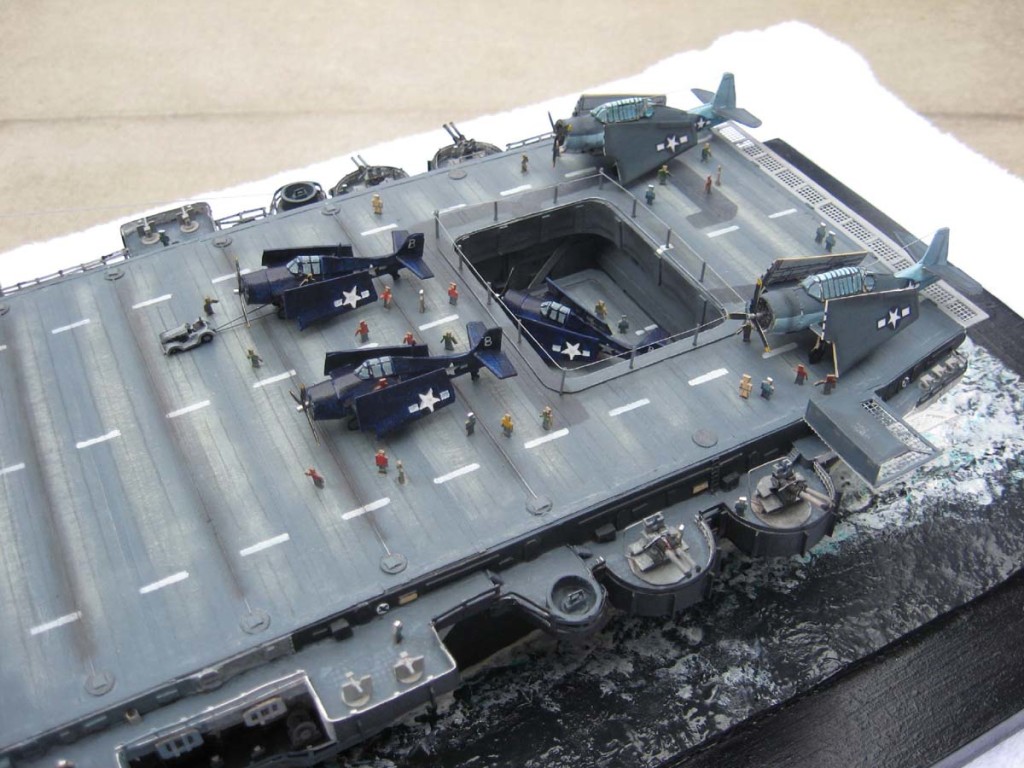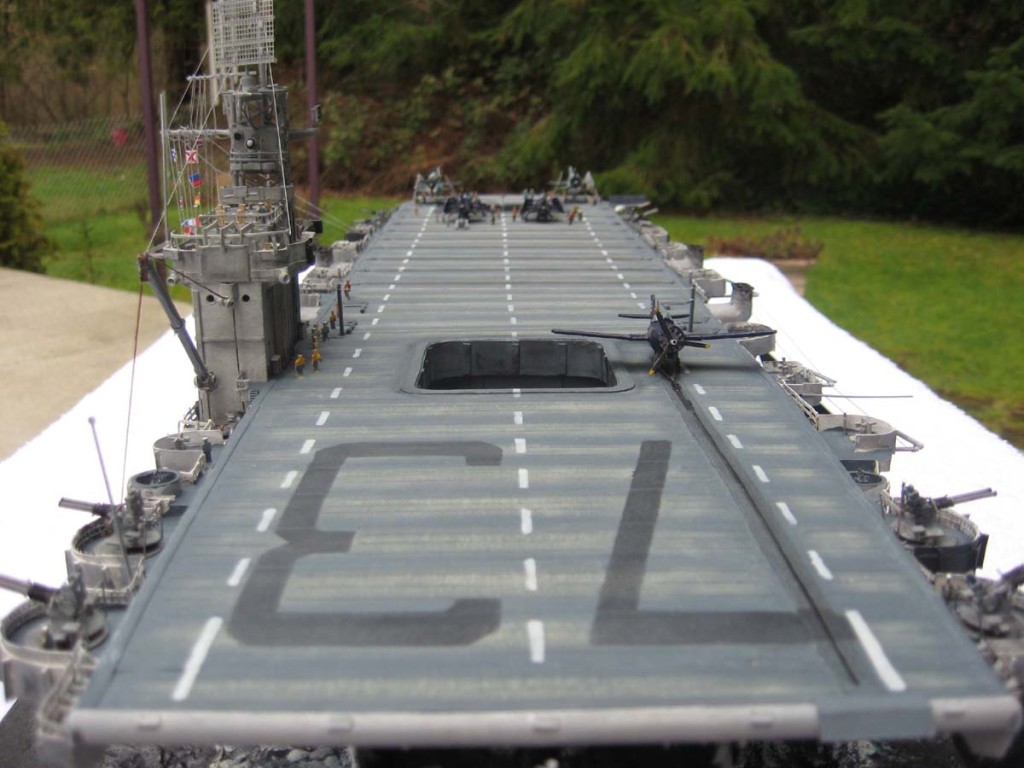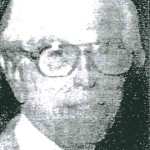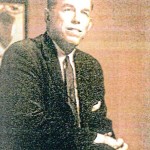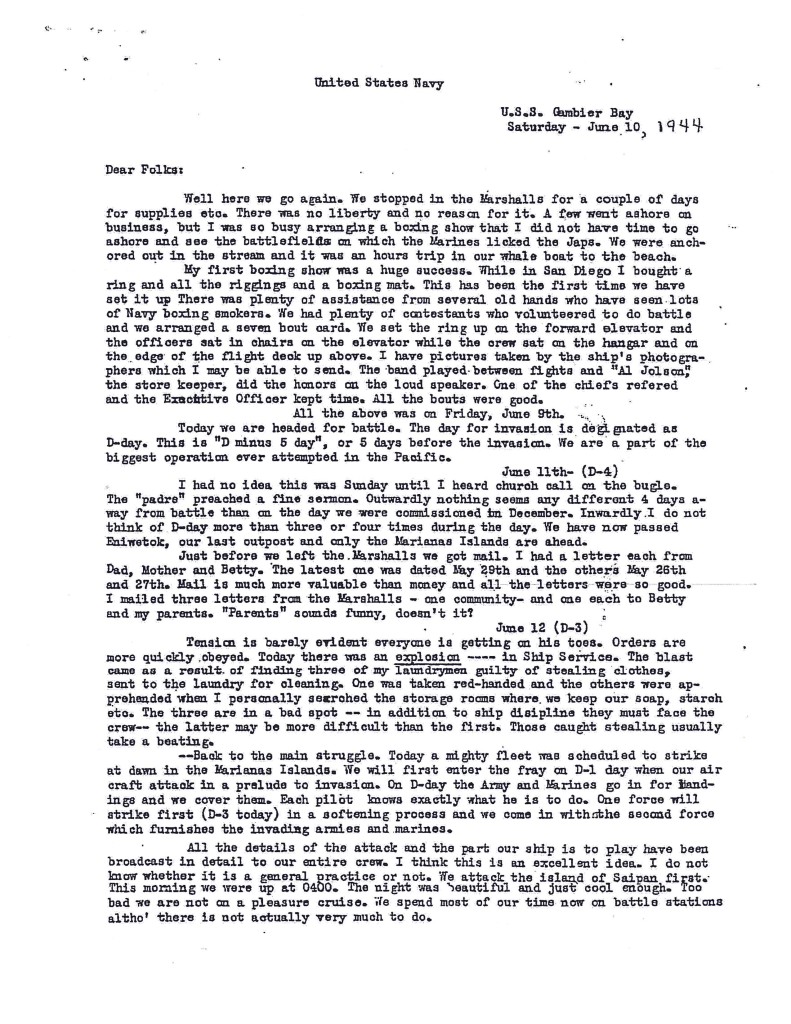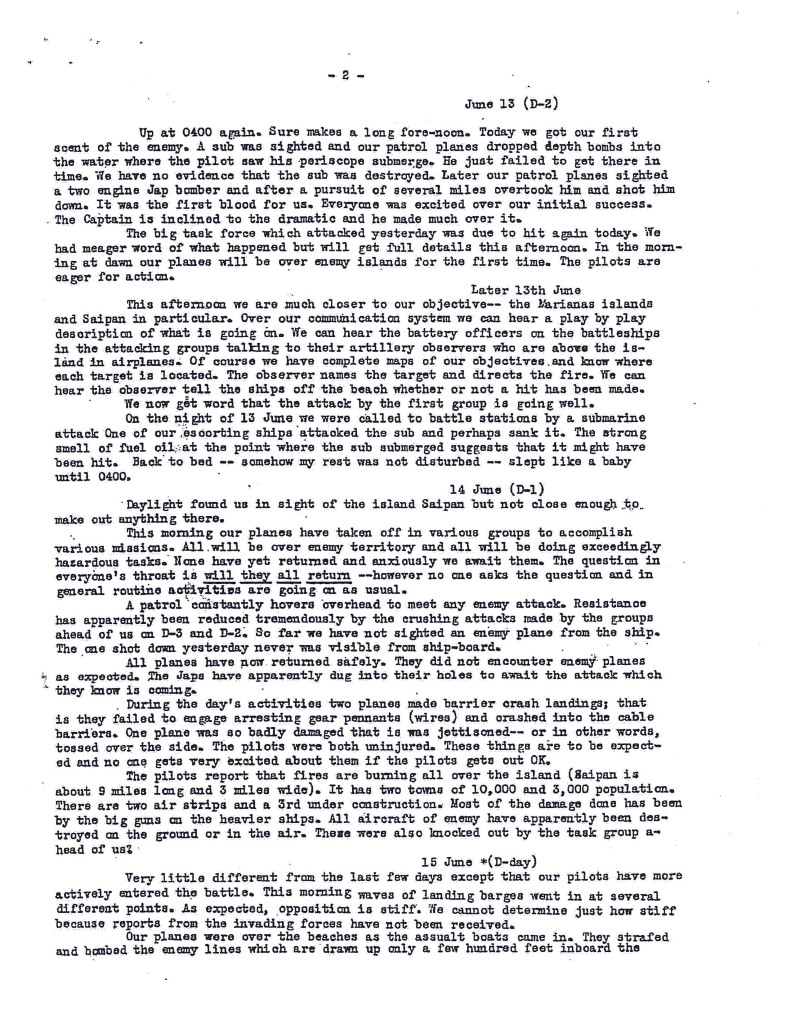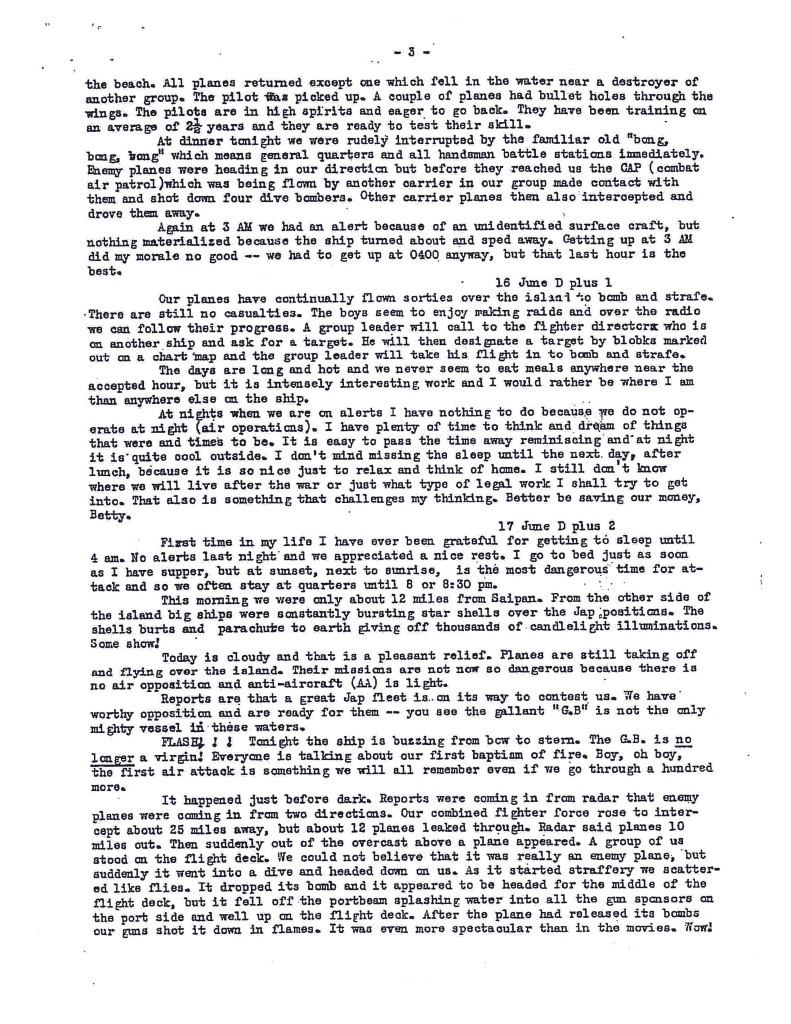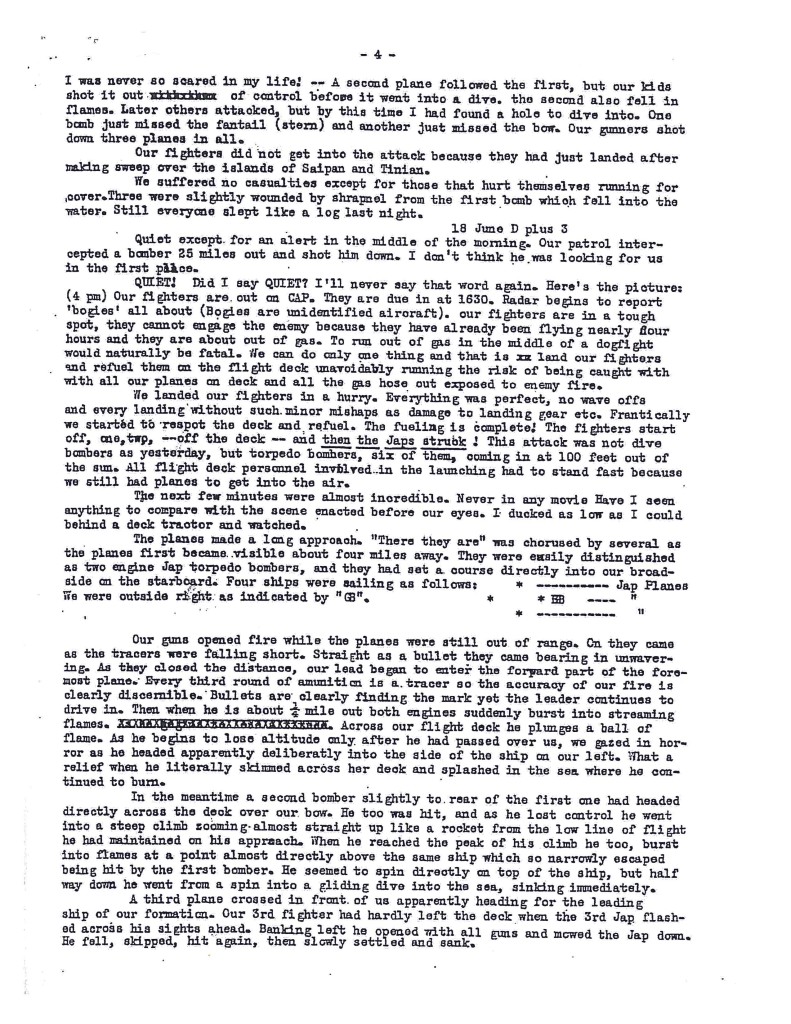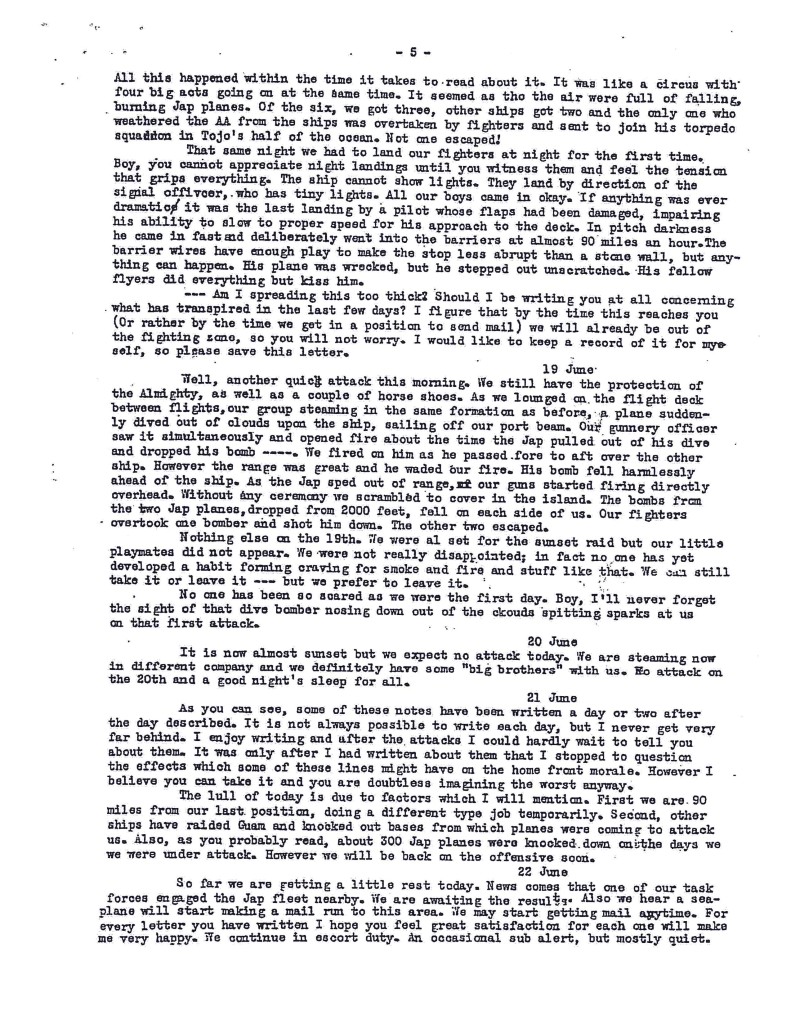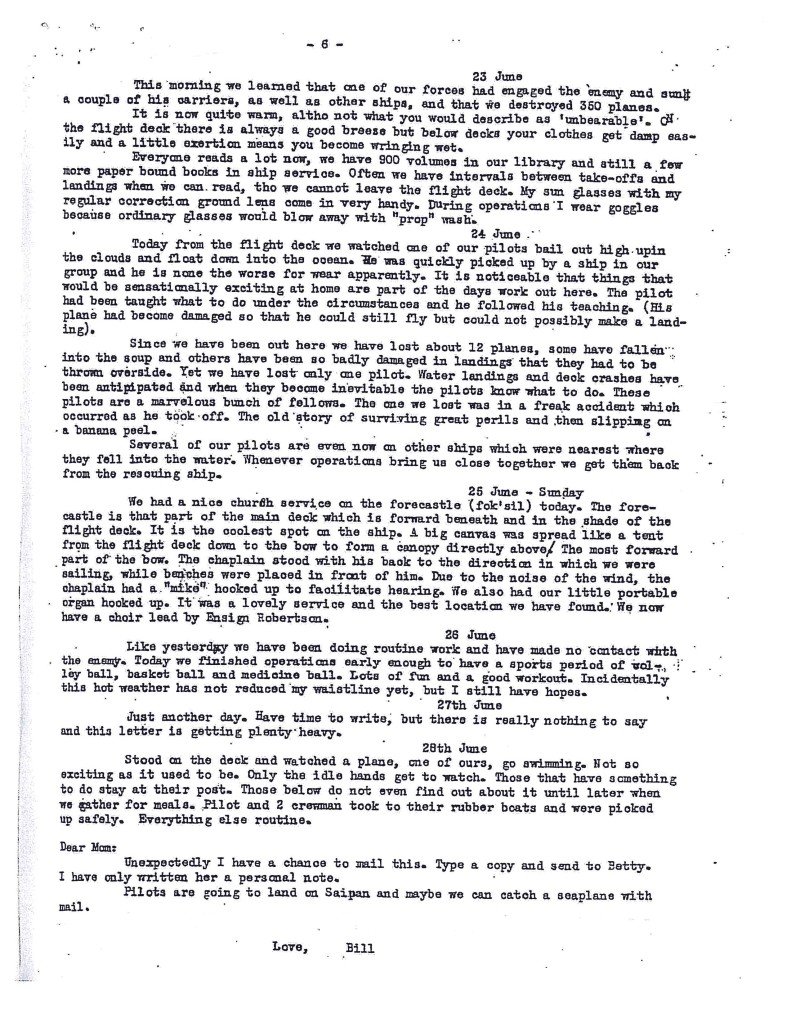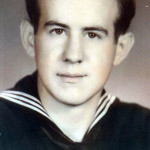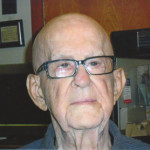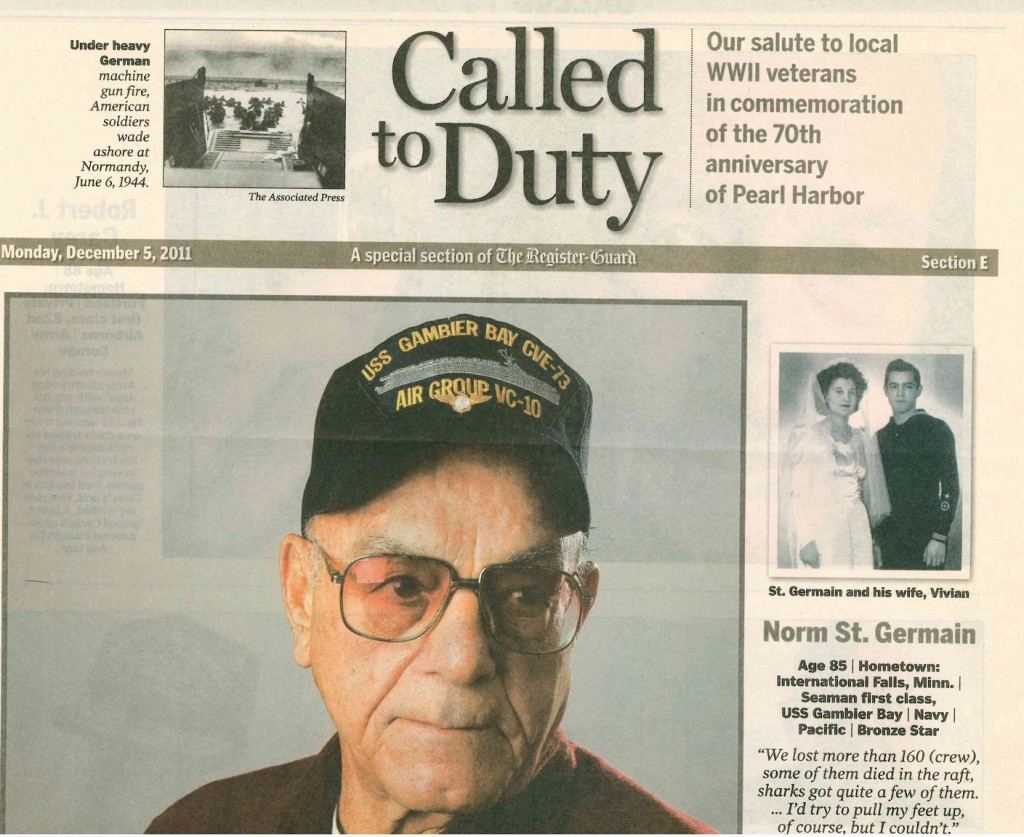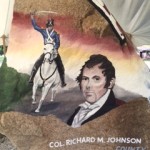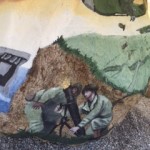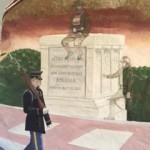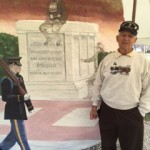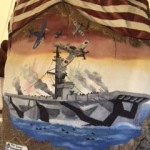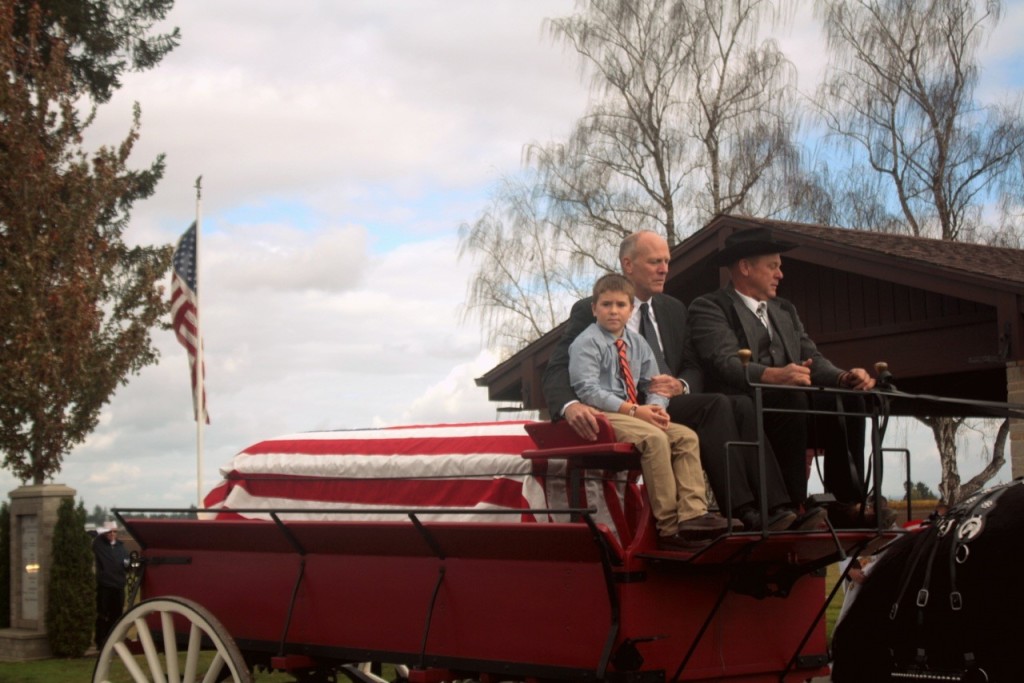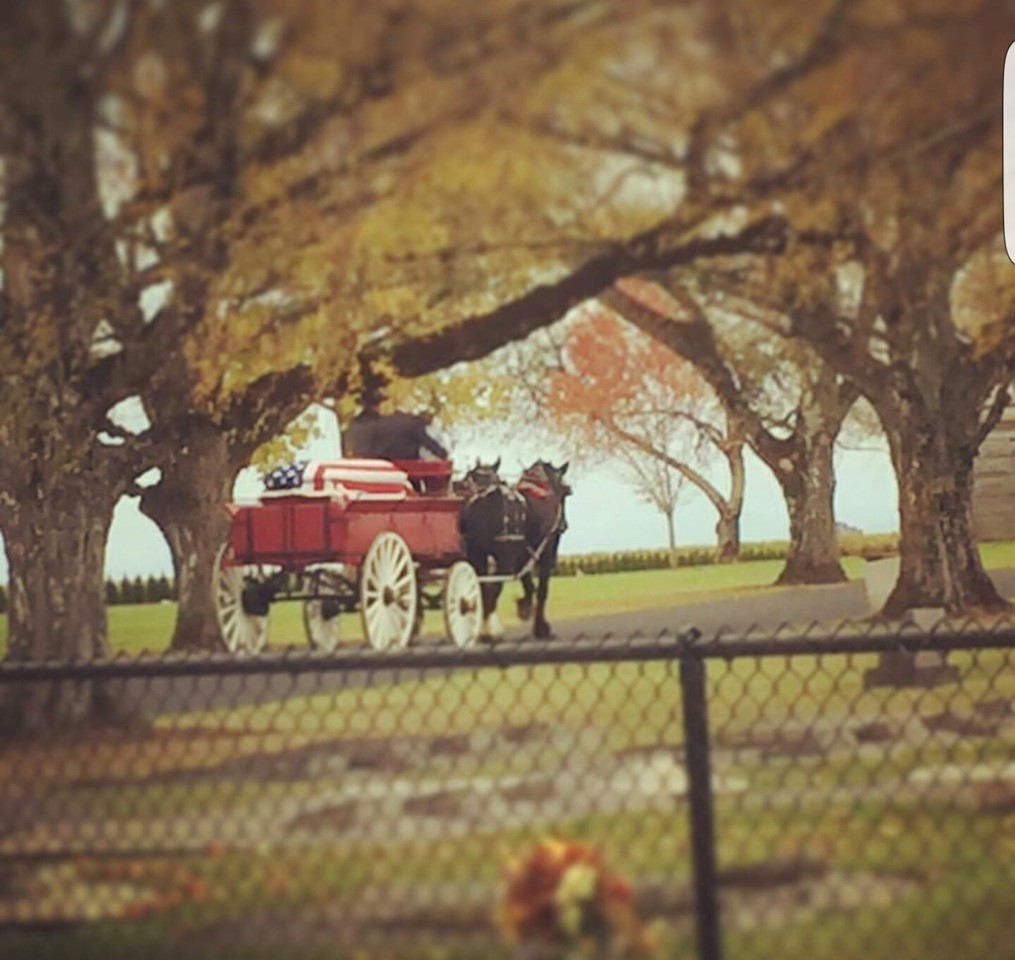Cmdr James Sanders – Receiving Bronze Star

James crossed the bar in February 1974
* * *
Lifelong USS Gambier Bay friends Dick (Spark) Pinch and
Dean Moel – Published in the Cedar Rapids Gazette / 1944

Dean (L) and Spark (R) – January 2015

Dick (Spark) Pinch crossed the bar in November 2015
* * *
USS New York – A Tribute From The World Trade Centre
It was built with 24,000 tons of scrap steel from the World Trade Centre. It is the fifth in a new class of warship – designed for missions that include special operations against terrorists. It will carry a crew of 360 sailors and 700 combat-ready Marines to be delivered ashore by helicopters and assault craft. Steel from the World Trade Centre was melted down in a foundry in Amite, LA to cast the ship’s bow section. When it was poured into the moulds on September 9, 2003, those big rough steelworkers treated it with total reverence, recalled Navy Captain Kevin Wensing, who was there. It was a spiritual moment for everybody there.
Junior Chavers, foundry operations manager, said that when the World Trade Center steel first arrived, he touched it with his hand and the “hair on my neck stood up”. It had a big meaning to it for all of us he said. They knocked us down – they can’t keep us down –
we’re going to be back.

THE SHIPS MOTTO – – – NEVER FORGET
***
Boy Its Cold – Patrick Akers
In late October of 1944, Patrick Akers floated for over two days in the Pacific Ocean off the shores of the Philippines, fighting off sharks and dehydration, but the one thing he remember the most: “It was cold.”
Akers, 86, currently of Iowa City and formerly of Williamsburg, served in the Navy on the USS Gambier Bay during World War II and was part of the Battle of Samar, deemed to be the largest sea battle of all time in terms of the number of ships (282), men (190,000) involved, and the vast area (nearly 500,000 miles) over which it was fought.
It was during this battle, taking place October 25, 1944, in which the USS Gambier Bay was sunk by a Japanese fleet, that Akers and his fellow crewman found themselves bobbing in Leyte Gulf for 50 hours.
Akers, original from Morse, was a 25 year old making parts for tanks at John Deere in Walterloo when he was drafted into the Navy, May 3, 1944. He was married to his wife Vivian at the time, and they had three children: Sheila, Nancy, and Patrick, with a fourth, Mary, on the way. “We never in all the world though he would be drafted,” said Vivian Akers, who moved home to Iowa City when Akers left for duty.
Seven of Akers’s brothers were already serving in World War II, two were in the Marines, one was in the Navy, and the rest were in the Army. Akers knew he didn’t want to crawl through trenches, so he signed up for the Navy. “My brothers slept in the ditches. I didn’t want to go to the army,” he said. “I was pretty well satisfied with the Navy.”
A seaman second class, he was put on the USS Gambier Bay, a carrier that transported aircraft to small island in the Pacific. The planes bombed the small islands and the marines followed, securing the islands. Akers’s brother Joe was one of the marines on land, and he was always one island ahead.
Akers’s job was to crank up the wings of the planes during preparation for takeoff. He was up at 5 am every morning, and they had to be on top of the carrier before everybody else to warm up the planes and get them ready to go. “One of the good things was I didn’t have to wait in the chow-line,” he said.
Originally, Akers wanted to be a cook, but his job on top of the carrier turnout to be a fortunate turn of event. When the Gambier Bay was sunk, may of the cooks working below didn’t make it or were severely injured.
The Battle of Leyte Gulf resulted from the Japanese response to the American invasion of the Philippines, October 20, 1944. The American fleet in the Gulf was overwhelming, so the Japanese sent a decoy, a large portion of the American fleet was pulled out, chasing phantom ships. Three groups were left to guard the Gulf. A Japanese fleet of four battleships, eight cruisers, and 13 destroyers moved in from the north, south, and center of the Philippines. The call of attack came just before 7 am that fateful morning. Akers never got to eat breakfast.
The battle lasted only two hours long, but it seemed like days.
Akers hurriedly cranked up the wings of the carrier’s 30 planes while explosions wracked the ship. Every plane got off except for one, which was hit with a shell. “They shot the devil out of us”, Patrick said. He said the Japanese were using the wrong shells. The torpedoes went right through the hull of the Gambier Bay without exploding. Otherwise the ship would have taken a lot more damage. The Gambier Bay was the only ship that was “shot up,” Akers said. Another hallmark of the Battle of Leyte Gulf was it was the first engagement in which the Japanese used kamikazes, or suicide planes. “They did a lot of damage with the suicide planes. We saw a lot of kamikazes” Akers said. “They were like a big ball of flames.”
Akers was busy preparing planes for flight when the call to abandon ship came at 8:05 am. The American Sailors formed a line as smoke billowed around them, and one by one dropped 15 to 20 feet into the frigid, gray ocean below. A fellow sailor Akers talked to later said for some reason before he jumped into the Pacific, he stopped to take off his shoes and socks.
Once they were in the water, the sailors swam to lifeboats, which Akers said were porous from bullet holes. The wounded stayed in the rafts. Everyone else hung onto the sides, taking 10 minute turns in the rafts. They wore donuts around their waists, which were like small, rubber inner tubes. “They weren’t very good, “Akers said.
Eventually, the Japanese sailed right up to the Gambier Bay, and Akers said he could see his attackers. He said there were some reports of the Japanese throwing potatoes and onions at the American sailors. “You just keep still for fear they would shoot us,” he said. Takeo Kurita, the Japanese vice admiral, reportedly told his sailors not to shoot Americans in the water, and there were other reports of Japanese sailors helping American Sailors into life rafts. The Japanese eventually left, and Akers and his fellow seamen were left alone, floating in the Pacific, where they would stay for the next two days.
To sleep, they would use a buddy system. One man would lay his head on the shoulder of another and snooze, while the other stayed awake. They tended to the wounded the best they could. Akers used a silver dollar and sulfur powder to cover a hold in the leg of a “big red-headed guy.” But then the sharks came. Attracted by the white sailor uniforms, the sharks started pulling away the wounded sailors. Akers said he kicked his feet and made as much noise as he could to scare the predators away. “There were a lot of them,” he said. Other sailors started to get delusional. Akers said some would say they were going to get a beer, and they would just swim off into the wild blue yonder. Others swam to hallucinated islands, never to be seen again. “There is nothing you can do, but just let them go,” he said.
Akers said nobody really knew what to do. They thought there was a nearby island, so they figured the tide would carry them into land. Meanwhile, a search plane identified them in the water, but gave the wrong direction sot the search party, who spend 19 hours trying to find them before giving up the search. Finally, in the wee hours of Friday, October 27, a landing craft discovered the remaining crew of the Gambier Bay. To make sure they were rescuing Americans, they called out and asked won the World Series. After receiving the right answer, after 50 hours in the ocean, and floating 30 miles from where the Gambier Bay was sunk, Akers was rescued.
“If they had picked us up sooner, a lot would still be around,” he said. One sailor who died was Mearl Barnett of Oxford. After he was rescued, Akers went to Australia where they stayed one night. They picked up supplies and headed home for a 30-day survivor leave. Meanwhile, back at home in Iowa City, Vivian was clueless to what her husband had gone through. She hadn’t heard from him in three months. She did not even know what ship he was on. Vivian just knew he was on a carrier.
Mary Akers, now Mary Fox of Williamsburg, was just three days old when Vivian read in the paper the Gambier Bay had sunk. Then Akers came home for Thanksgiving on his survivor’s leave. From floating in salt water for so long, he had developed sores and scabs all over his body. He had to take some shots, but otherwise he was healthy. He still has the watch he wore for those 50 harrowing hours.
After his 30 days, he was reassigned to another ship, but due to a steering malfunction, the boat ran aground. A measure was passed sending home people with two children or more. Otherwise, Akers was off to Japan. He was honorably discharged November 21, 1945.
Akers worked in dry cleaning and performed maintenance for 30 years in Waterloo and Iowa City before retiring to Williamsburg in 1984. In 1998, he and Vivian returned to Iowa City. Now in his spare time, Akers does woodworking and fixes up antique cabinets. He gives most of them to his grandchildren, but he also sells some.
He has suffered two strokes and his left leg was temporarily paralyzed, but Akers said he is “coming out of it pretty good.”
September 3, he and Vivian will attend a reunion for survivors of the Gambier Bay in Washing, D.C. Several books have been written about the sinking of the carrier, including “The Last Stand of the Tin Can Sailors”, and The Men of the Gambier Bay.”
Akers keeps in regular touch with other survivors who survived the ordeal. “You make a lot of friends and a lot of them you don’t forget,” he said.
For his service during World War II, Patrick was award the Honorable Service Lapel Button, the Navy Discharge Button, the Asiatic Pacific Campaign Medal with Two Bronze Service Stars, the African Campaign Medal, and A World War II Victory Medal.
Patrick crossed the bar in September 2009.
Article was published in the Williamsburg Neighborhood Newspaper – September 2008
* * *
Gambier Bay Look Outs – July 22, 1944
A Damned Sight Closer to Japan Than Home
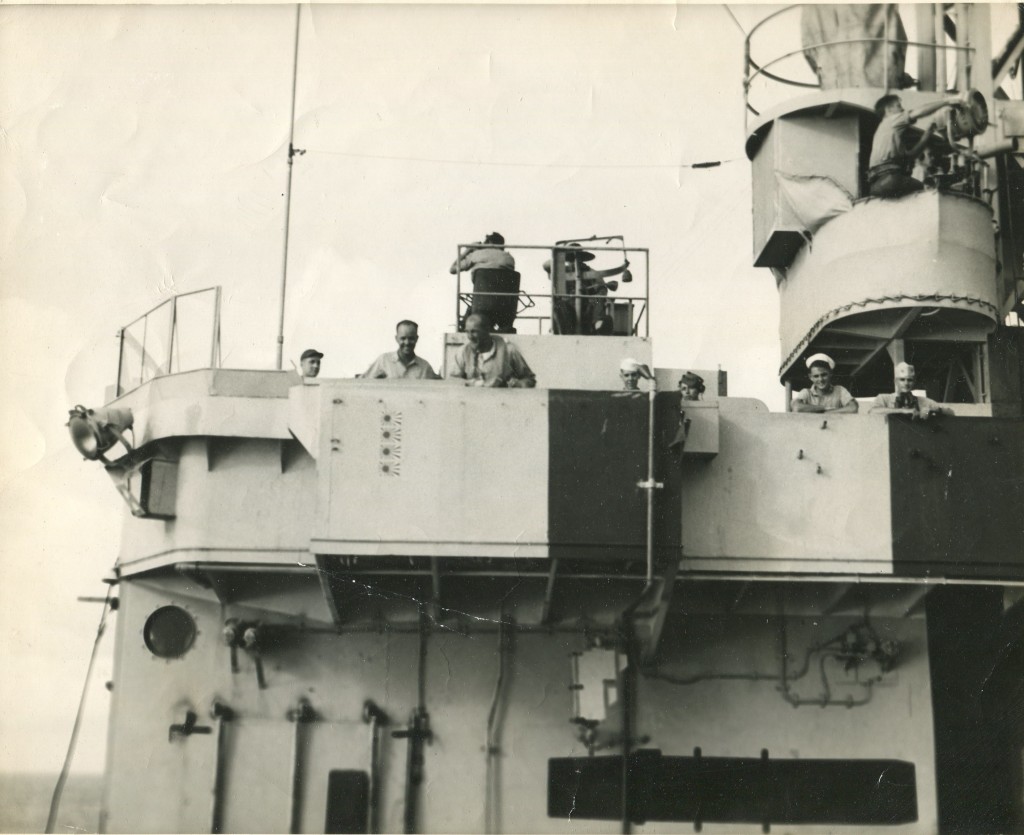 Captain H. H. Goodwin (standing over the Japanese flags), Comdr Buzz Borries next to him, Lt. R.J. Foley in the background with the bseball hat, Lt. Dick Griest (gunnery watch officer)
Captain H. H. Goodwin (standing over the Japanese flags), Comdr Buzz Borries next to him, Lt. R.J. Foley in the background with the bseball hat, Lt. Dick Griest (gunnery watch officer)
Captain Goodwin crossed the bar in 1980
Comdr Buzz Borries crossed the bar in 1969
Lt. R.J. Foley crossed the bar in 1964
Lt. Dick Griest crossed the bar in 2001
Photo submitted by Robert Foley (son of Lt. R.J. Foley)
* * *
Harry O. Miller – Helped Rescue Gambier Bay Survivors
Harry O. Miller, 92, formerly of Loogootee and Pulaski County, died December 24, 2014. Harry was born April 28, 1922, in Pulaski County, to the late Dennis and Mary K. (Katie) Umphrey Miller.
Mr. Miller faithfully served his country during World War II in the United States Navy in the Pacific Theatre. He was awarded the Bronze Star while serving aboard the PC 1119 for rendering medical aid in a 24-hour period to 183 souls rescued from the USS Gambier Bay (CVE 73), which had been sunk by enemy fire. He was honorably discharged as a Pharmacists Mate First Class in December of 1945. Upon completion of his service, Harry resumed his career as a funeral director which he started prior to his Navy service.
Harry was the owner of Miller Funeral Home in Loogootee following the war until he retired in the early 1970’s. His retirement was short lived as he returned to his calling of funeral service at the Jordan Funeral Home, the Dorsey-Feeney Funeral Home, the Little & Sons Funeral Home in Beech Grove through the early 70’s until the late 80’s. In the early 1990’s, he joined the family at Flanner and Buchanan in Zionsville where he was an active funeral director caring for the community well past his 85th birthday. 2014 marked his 73rd year as a licensed funeral director and embalmer in the state of Indiana, a milestone that he was extremely proud of.
Mr. Miller was a member of Zionsville United Methodist Church, the Indiana Funeral Directors Association; charter member and over 60-year member of VFW Post No. 1728 in Winamac; life member and past chaplain of American Legion Post 79 in Zionsville; and a life member of the Patrol Craft Sailors Association. Harry will be remembered for his giving spirit, his warm smile, hearty laugh, and his endless amount of tall tales. “Handsome Harry-O” will be fondly remembered and forever missed.
Harry is survived by his wife, Lois Arlene Torgerson Miller; his son, Timothy John Miller of Greenwood; his daughter, Rebecca Ann Miller of Indianapolis; his niece, Cathy Fahler Schmicker; his stepchildren, Thomas M. Torgerson and Kimberly Torgerson; and his foster grandchildren, Lauren and Brad Budrow.
Harry was preceded in death by Irene Miller, sister, Glynn Miller Kindig, sister, Ira Miller, brother, Charles Miller, brother, Ida Ruth Miller Fahler, sister, Paul Miller, brother, and Loren Miller, brother. He was also preceded in death by Charles (Chuck) Fahler, nephew, Kelly K. Kindig, nephew, and Karen Kindig, niece.
Thank you Harry for your service to our country and for
rescuing our Gambier Bay survivors.
***
Allen R. (Johnny) Janz, 89, Fargo, ND, passed away Saturday, March 14, 2015, at Maryhill Manor in Enderlin, North Dakota.
Allen Robert Janz was born and raised in Enderlin on April 24, 1925. He was the son of Robert and Clara (Fritz) Janz. His dad nicknamed him John, and everyone knew him as Johnny Janz.
John spent his early years in Enderlin playing Legion baseball and attended Enderlin High School playing baseball, basketball, and football. John graduated with the class of 1943, but was already serving in the United States Navy enlisting in February 1943.
After enlisting, John trained as a radioman at Farragut Naval Training Station, Bayview, Idaho. He received his assignment to the Naval Station in Bremerton, WA and was deployed aboard the USS Gambier Bay CVE73, an aircraft carrier that was sunk by the Japanese in the South Pacific on October 25, 1944. John was one of almost 800 men that survived in the ocean for 2 days and 2 nights until rescued by a Naval Patrol Craft. Following a one month leave, he returned to Bremerton and was assigned to the not-yet built carrier USS Rendova. Awaiting completion, John played baseball at the naval base. The Rendova shipped out of Portland, OR, and transported supplies and planes from San Diego to Hawaii, and eventually supported land and air attacks off New Guinea and Guatalcanal. The USS Gambier Bay and personnel received the American Presidential Unit Citation to Taffy 3 for extraordinary heroism in the Battle of Leyte Gulf off Samar. For his service, Janz received the American Campaign Medal, the Asiatic Pacific Service Medal with three Bronze stars, the Philippine Liberation Medal with two Bronze stars, and the World War II Victory Medal. In April 1946, he was honorably discharged. John also received an Armed Forces Reserve Medal for 32 years of service in the Naval Reserve, and earned the rank of Chief Petty Officer.
Johnny played baseball at Kensal, ND in the summer of 1946, before attending North Dakota State School of Science for Television and Radio Electronics. He also played baseball, football, and basketball for the Wildcats and graduated in 1948. In 1996, he was inducted into the NDSCS Wildcat Athletics Hall of Fame.
In 1948, Janz opened his own repair shop in Enderlin, and also began working for the Enderlin Post Office. In 1968, he became Postmaster and served in that capacity until retiring in 1980.
Johnny was active in Babe Ruth and American Legion Baseball in the Enderlin area for many years. It was from Legion competition that he gained the experience that made him a prominent figure in amateur baseball years later. While playing with the Enderlin Legion team they were state champions in 1940 and 1941 along with a runner-up finish in 1942. The 1940 Enderlin team also won the regional championship in York, NE. After serving in the armed forces and attending college, Johnny joined the Enderlin Independent (Indies) team in 1948. Enderlin was state champions in 1952, 1953, 1955, and runner-up in 1954. A pitcher-outfielder, Janz played on all of those teams and was an all-state tourney selection five times. He was named North Dakota’s MVP in 1952 and pitched a perfect no hit, no run game in the 1955 state playdown. Janz retired as a player in 1962. He was inducted into the North Dakota Amateur Baseball Hall of Fame in 1976.
Johnny married his baseball coach’s daughter, Dorothy Redmond on June 1, 1952. Married for 61 years, they raised two children in Enderlin. John was a member of Trinity Lutheran Church, First Lutheran Church, and Cormorant Lutheran Church. He served on the Board of Directors for the Enderlin Golf Course, Enderlin Park District, and Enderlin Baseball Association, and was a Life Member of the Enderlin VFW and American Legion, and member of the Eagles in Valley City.
Johnny and Dorothy spent many memorable early years at hundreds of baseball games, and with their children camping at Lake Ida with friends and relatives. They also enjoyed many Canada fishing trips to Flin Flon and Cranberry Portage with family and friends. Following his USPS retirement, John worked as Director of Postal Operations at Concordia College from 1981-1984 and moved to Fargo/Moorhead and Lake Ida, near Cormorant, MN. They spent their spring through fall months in Minnesota, and enjoyed 23 years wintering at Green Bay South near LaFeria, TX, until 2008. In 2007, John and Dorothy were selected for the second “Honor Flight” to the World War II Memorial in Washington, D.C.
Johnny finally got his “hole in one” on a 193 yard drive on Hole #13 at The Palms Mid Valley Golf Course, Mercedes, TX on February 14, 2000. John is remembered for the bounce in his step, his love of fishing and the lake, being a die-hard Twins baseball and Bison football fan, listening and dancing to Frank Sinatra music, and enjoying his grandchildren and great-grandchildren. Johnny lost the love of his life when his wife Dorothy passed away on April 8, 2014.
John is survived by two children: Steven (Kari) Janz, Moose Lake, MN, and Joni (Jeff) Peterson, Fargo, ND; five grandchildren: Brittani Janz, Natalie (Jon) Beckstrand, Jordan (Alyssa) Sauvageau, Zachary Janz, Savanna Sauvageau (fianc Q. Dillon); and seven great grandchildren Emma, Carlos, Julian, Daymian, Nicolas, Quincey, and Peyton. He is also survived by in-laws Donald (Janice) Redmond, Lloyd (Donna) Redmond, Carol Ann Pudwill, Karen Redmond, and many Janz and Redmond nieces and nephews who fondly called him Uncle John.
His grandchildren and their spouses served as Honorary Pallbearers.
He was preceded in death by his wife, Dorothy, parents Robert and Clara Janz, brothers Arthur and Lloyd Janz, and in-laws Jesse Lee (Pete) and Lucille Redmond, and Darrell Redmond.
* * *
March 21, 2015
Damian Petro (great nephew of Cmdr James Sanders)
presenting his scratchbuilt model of the
USS Gambier Bay to the Oregon Maritime Museum in Portland, Oregon
This is my model of the USS Gambier Bay CVE-73 which is scratch built from cardboard and is in 1/200th scale. The model shows how she looked on the morning of October 25,1944, the day she was lost to the Japanese in The Battle Off Samar, Philippines. This model is special to me because my great uncle, James A. Sanders, was the chief engineer on the Gambier Bay during all of her service life including the day she went down. It will be a homecoming of sorts because she was built in the Kaiser shipyards in the Portland area.
Bob Woolsey (currator), Damian Petro, Arlen Cole (President, Oregon Maritime Museum)
Addiditonal photos can be viewed at
http://www.modelshipgallery.com/gallery/cv/cve-73/GambierBay-200-dp/index.htm
* * *
J.W. “Bill” Patterson
McAllen, Texas – J.W. “Bill” Patterson, Jr., 70, passed away at the McAllen Medical Center on July 9, 1998, after a brief illness.
Born in Hillsboro on August 28, 1918, he was the first of three children of Martha and J.W. “Joe” Patterson. He graduated from Hillsboro High school as valedictorian of his class. He and Dave O’Brien were the two quarterback/halfbacks on the first Coach’s All-Star game in Dallas in 1935.
He went to Baylor University on an athletic scholarship where he lettered in football, baseball, and track before earning a bachelor’s degree in 1939 and a law degree in 1942. He was All-Southwest Conference in football in 1937 and All-Southwest Conference and All-American in 1939. He was invited to play in the East-West Shrine game in San Francisco in 1939, and was named the game’s most valuable player.
While in law school at Baylor and University of Texas, he played professional football in the NFL with the Chicago Bears and the Pittsburgh Steelers before entering the Navy, where he was an officer in the Naval Reserve for four years. He was on the aircraft carrier the Gambier Bay, sunk by the Japanese in the Pacific campaign. He was the youngest president of the Baylor Ex-students Association and serviced two separate terms on the Baylor University Board of Trustees.
In 1942, he married Betty Burkhart of Alamo, and in 1946 they returned to McAllen, where he began a distinguished career in the practice of law. Active in civic affairs, he served three years as president of the Rio Grande Council of Boy Scouts of America, was president of the Lions Club and was active in the Fellowship of Christian Athletes.
Bill was inducted into the Hillsboro Chamber of Commerce Hall of Fame in 1987, the Texas High School Football Hall of Fame in 1988, the Baylor Lettermans Hall of Fame in 1962, and the Rio Grande Valley Sports Hall of Fame in 1995.
He had been active in the First Baptist Church since 1946, where he served on the Board of Deacons, and taught an adult Sunday School class until his entry into the hospital.
He was devoted to his family and had been a mentor to many through the years. He was preceded in death by his parents and his brother, Harry W. Pattterson of Houston. Surviving him, in addition to his wife of 56 years Betty, are a son J.W. “Joe” Patterson III of Mission, two daughters, Dians (Eddie) Marburger of Mission and Debbie (Randy) Davis of Arlington, five grandchildren, and a sister, Elizabeth Young of McAllen.
*
Dear Folks – Letter from Bill Patterson / June 1944
Letter published with the permission of
Betty Patterson, widow of Bill
Bill crossed the bar in July 1998
* * *
Happy Birthday Harvey Yarno
Harvey Yarno, of Manteno Veterans’ Home, was born May 28, 1925, in Fowler, Indiana. He moved to Kankakee with his parents, Pete and Edna Yarno. He has four brothers: William, Richard, Wayne (deceased) and Leroy (Donna) Yarno, of Kankakee. Harvey served in the U.S. Navy in World War II Pacific conflict on the USS Gambier Bay. He was married to Mae E. Weiss (deceased), of Moorhead, Minnesota, for 60 years. Harvey has one son, Larry R. and daughter-in-law Mary B. (St. John) Yarno. He has three grandchildren and six great-grandchildren. Harvey retired from Kankakee Roper Stove after 21 years. Now he enjoys golf, playing cards, visiting relations in Moorhead and Fargo, and being with family.
Published in the Daily Journal/Kankakee, Illinois
* * *
“I’m Going To Die Right Here” by Norm St. Germain
It happened nearly 70 years ago, and yet now, at 85, he thinks about it nearly every day.
The geysers from Japanese artillery fire shooting into the air around the shop. The blast that took a pal’s head off. The frantic Dlimb down the monkey rope as the ship started to list. The screams of guys on the outside of the life raft who’d been attached by sharks.
Norman St. Germain of Springfield believes he’s the youngest surviving member of the October 25, 1944, sinking of the USS Gambier Bay during the Battle of Leyte Gulf.
With is parents’ permission, he enlisted as a 17-year-old, one of four St. Germain boys in the military.
Only one wouldn’t make it home to International Falls, Minnesota, Orel, who survivor the Bataan Death March in the Philippines in 1942, later died in a prison camp. “He was my hero,” St. Germain says. “H could throw a baseball through a barn door.”
When the USS Gambier Bay came under fire that morning, St. Germain figured he wasn’t coming home, either. “The bombs kept hitting us every 30 to 60 seconds, andeverything was shaking and I strated thinking, “well, this is it. I’m going to die right here.”
“Right here” was about 60 miles east of the island of Samar in the Philippines.
“One of our engines flooded, and we were literally dead in the water, he says. “ I was going down over the shop’s side on that monkey rope and a buddy yells, “Saint” – that’s what they called me “Saint – Better hurry, it’s gonna roll.”
He let go and splashed into the sea. He found a raft to cling to and watched the ship, minutes later, slip into the depths.
“It’s an emotional thing,” he says. “That’s your home.”
Many survivors, including St. Germain, expected rescue within hours. But the US fleet in that area had been decimated. Night came and went.
The survivors had little food or water.
“The sun was baking down, and we’d take turns hanging on the outside of the raft,” St. Germain says. “It was a deadly game of musical chairs. I remember seeing the sharks – 6 to 7-footers – but for some reason they left me alone.” A second day turned into a third, some men hanging to the outside were so tired they had to have their wrists tied to the boat to keep from drowning.
Of the 950-man crew, 200 died, according to “The Men of the Gambier Bay.”
St. Germain’s group was rescued by a US amphibious assault ship on the third day.
“The deck was full of guys just lying there, so tired,” he says. “They say I never talked much after. I just sat there are stared.”
Reprinted with permission from Bob Welch of the Register Guard, Eugene, Oregon
* * *
Charles Altiman – Hometown Memories
November 5, 1997

Charles Altiman was KIA
Submitted by his nephew, Randy Altiman
* * *
The Freedom Rock Tour / Iowa
The tour was created by artist Ray “Bubba” Sorensen II, and aims to boost tourism and spread the message of thanking our Veterans while providing a unique to their area Freedom Rock for all 99 counties in the great state of Iowa.
For more information visit – http://www.thefreedomrock.com
- Dean Moel, USS Gambier Bay Survivor
- USS Gambier Bay
* * *
Well-Know Salem Real Estate Developer Dies
Larry Epping, a longtime real estate developer in the Mid-Willamette Valley, died Thursday, October 22, 2015, at his Salem home. He was 94.
His family said he had been experiencing recent health complications, but up until around the time he celebrated his birthday in August, was still showing up to work almost daily at his office on Lancaster Drive NE.
Epping launched his development business in 1946, after returning from service as an officer in the Navy during World War II, and he became known for building affordable homes.
In recent years, he was known more for his philanthropic activities. The Larry and Jeannette Epping Family Foundation donated $200,000 to the Oregon World War II Memorial project, for example, and he helped cut the ribbon at the dedication ceremony June 6, 2014.
“He was absolutely pivotal in making that happen,” said Lou Jaffe, president of the foundation that raised money for the memorial on the grounds of the State Capitol.
Epping’s wife preceded him in death in 2013. The family foundation also donated land for Blanchet Catholic School and land for a future park in Silverton.
“The most important thing was his desire to give back to the community,” said son Randy Epping, noting that his father’s family came to Oregon after losing their farm in North Dakota during the Dust Bowl. “They had no money. The kids worked in the fields. His life in Oregon is a true success story, to be able to build up his business to where now most all of the money goes to supports the foundation.”
Mike Erdmann, chief executive officer of the Home Builders Association of Marion and Polk Counties, said Epping’s death would be felt across the Mid-Valley. He said Larry and his wife gave a tremendous amount to the community, and that almost all of it was “off the radar.”
“Larry was without a doubt the patriarch of the home-building industry in Salem, but he never sought public recognition for his generosity,” Erdmann said. “He gave because it was the right thing to do. He sold affordable homes to home buyers and gave them financing when others wouldn’t. And he did the same for countless homebuilders over the years. When other banks wouldn’t lend them the money, Larry would. That was Larry. He will be missed.”
Epping’s World War II service, until just a few years ago, also was under the radar. He was modest about being called a hero when he spoke to a Statesman Journal reporter in 2013.
Epping served on the USS Gambier Bay, an escort carrier that was sunk during the Battle of Leyte Gulf, which is considered the greatest naval battle in history. He clung to the rim of a life raft for nearly two days in shark-infested waters.
The old saying goes, “In a life raft, there’s no one that doesn’t believe in the Lord,” he said at the time.
After the war, Epping started his development career. During his induction to the Oregon Building Industries Association Housing Hall of Fame in 2000, it was noted that he started with a single property lot and by that time, had built more than 1,000 homes priced for first-time buyers.
“Larry has been so instrumental is making sure that poor, vulnerable families, pregnant teens and foster children could be proud of where they lived,” said Jim Seymour, executive director of Catholic Community Services. “One way he did this was by making housing available to them and making sure it stayed in good shape.”
A rosary will be held in Epping’s memory at 7 p.m. Sunday, October 25, 2015, at St. Vincent Church in Salem. After a funeral mass will be held at St Mary’s Church in Mt. Angel, with burial following at Calvary Cemetery with full military honors.
Christian, grandson of Larry, Randy, son of Larry
